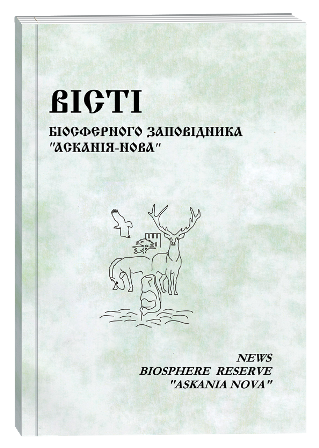CHARACTERISTICS OF A POLLEN AND A POLLEN REGIME OF SPECIES OF THE GENUS PICEA A. DIETR. IN THE DENDROPARK "ASKANIA-NOVA"
DOI:
https://doi.org/10.53904/1682-2374/2020-22/10Abstract
The results of pollen studies in 7 Picea species cultivated in the Dendropark "Askania-Nova", which have reached generative age, are highlighted. The pollen quality is determined according to its viability, fertility, structural deviations–anomalies. A pollen of P. koraiensis (95%) has the highest viability among spruces, P. schrenkiana (44%) – the lowest. An index of pollen fertility is the highest in P. abies (83−89%), and the lowest in P. schrenkiana (29−39%). Anomalies of pollen grains were revealed: small, hypertrophied, accrete, with an undeveloped body and mutations associated with deviations in the structure and number of air bags. A small number of pollen anomalies was noted in plants growing in the dendropark – from 0.89% in P. schrenkiana to 5.83% in P. koraiensis. The frequency of pollen anomalies increases in older individuals and in those, which are oppressed by diseases or are in an unsatisfactory vital state. The dependence of the pollen regime on the age of plants was determined by the example of P. pungens, which young individuals were detected less anomalies (0.99%) in comparison with middleaged ones (3.44%). The dependence of the quality of the pollen on a vital state of plants was determined in P. abies: individuals in an unsatisfactory vital state have 3.05% of anomalies in the structure of the pollen and 1.33% during its germination, individuals in a good vital state – 1.89% and 0%, respectively. A comparison of the pollen was made in four species of spruces that grow in different environmental conditions (control plants – in the park, experimental – at the territory of the settlement). The greatest diversity and the highest percentage of anomalies were found in P. pungens pollen at the settlement (3.1% in young plants, 19% in middle-aged plants).
References
Коршиков І. І., Гусейнова Е. Р. Особливості пилку рослин Рicea abies та Р. pungens (Pinaceae) в насадженнях на території Криворіжжя. Український ботанічний журнал. 2018. Т. 75, № 5. С. 446–456.
Лакин Г. Ф. Биометрия. Москва : Наука, 1982. 287 с.
Носкова Н. Е., Третьякова И. Н. Влияние стресса на репродуктивные способности сосны обыкновенной. Хвойные бореальной зоны. 2006. Т. 23, № 3. С. 54–63.
Паушева З. П. Практикум по цитологии растений. 4-е изд. Москва : Агропромиздат, 1988. 271 с.
Плугатарь Ю. В., Сахно Т. М. Биометрические характеристики и аэродинамические свойства пыльцевых зерен североамериканских сосен в условиях Южного берега Крыма. Изв. Сарат. ун-та. Нов. сер. Сер. Химия. Биология. Экология. 2018. Т. 18, вып. 4. С. 462–468.
Сладков А. Н. Введение в спорово-пыльцевой анализ. Москва : Наука, 1967. 275 с.
Тупицын С. С. Мужская генеративная сфера сосны обыкновенной (Pinus sylvestris L.) в разных экологических условиях (обзор) [Электрон. ресурс] // АгроЭкоИнфо. 2015. № 6. Режим доступа:http: //agroecoinfo.narod.ru/journal/STATYI/2015/6/st_30.doc. (дата звернення: 01.09.2020).







